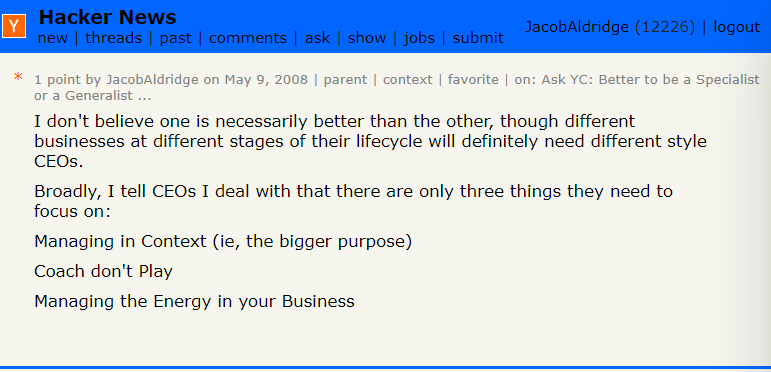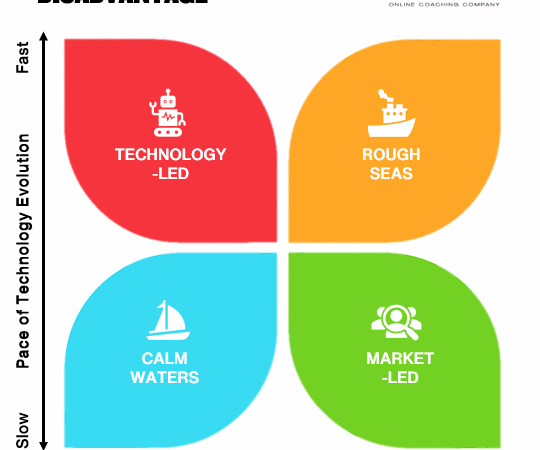I’ve worked alongside more than 2,000 founders: Here’s what Founder Mode means, and how you can apply this immediately.
Founder Mode: Buzzword or Your Secret Sauce?
Right now my business networks are obsessed with “Founder Mode”, all thanks to Brian Chesky (who founded Airbnb) and Paul Graham (who founded tech startup incubator YCombinator, and was thus the first investor in Airbnb, Dropbox, Zapier, Stripe, and many more).
So this week I’m turning my newsletter over to something that has struck a nerve because:
- Founder Mode is resonating hard with business owners worldwide – What is it, and why?
- Practical reality is proving wrong a lot of conventional business wisdom – Can your ‘gut feel’ truly outmanoeuvre 100 MBAs?
- It’s controversial, and awkwardly vague – Having coached 2,000+ Founders myself, how would I define ‘Founder Mode’ so you can leverage it to be happier and wealthier?
Founder Mode: Origins
Long time readers of my work will know I’ve been quoting Paul Graham (pg) since even before I trained as a business coach in 2006. His May 2004 essay “Mind the Gap” is still shared with most of my founder clients, and his 2009 “Maker’s Schedule, Manager’s Schedule” dovetailed so nicely into my work on Pace that it’s been referenced in multiple articles and videos.
This week pg published “Founder Mode“, his reaction to a YCombinator alumni + investor presentation delivered by Brian Chesky. Love or hate Airbnb, they’re a US$75 Billion company and the CEO is still the same guy who raised money for the company by selling Obama O’s cereal for $39 a box at the 2008 Democratic National Convention.

Founder Mode comes from a core principle: “There are things founders can do that managers can’t”.
An enormous amount of business advice is based on hiring and empowering great managers, dividing up responsibility as the business grows. This might be great advice for an employed CEO … but it feels wrong, and is wrong, when talking to actual founders.
“There are things founders can do that managers can’t”
Paul Graham
Where Does Jacob Fit In?
I don’t know pg or Brian personally but when I was starting out in business I spent a lot of time in their community on Startup News (now Hacker News). That community evolved to be more focused on Tech Startups, coding on ramen, raising capital, becoming unicorns (or glue). I evolved to be more focused on business, working with founders in private enterprise, developing over ~20 years a practical method for helping grow 12-100 employee businesses.
Different Founders, same challenge. As a leader in business, you fight to escape the Doing Phase (2-12 employees); then find yourself with time to work “on” the business but no experience or manual for what that actually means.
And you didn’t become a lawyer or a pest technician or an indiehacker because you were great at small business. So you either fumble around (most common), or you call someone like me (least common, most recommended), or you think “Those guys wearing suits in the fancy offices must know what’s happening, let’s hire one of them or at least copy what they’re doing.”
Founder Mode turns into Manager Mode. You just Copied the Wrong Homework…
Why is Conventional Wisdom Wrong? Manager Mode Works, Until it Doesn’t
This old video of mine explains 5 phases of business growth, based on headcount:
- DOING PHASE 2-12 people
- PROCESS PHASE 12-35 people
- CAPABILITY PHASE 35-120 people
- STRATEGY PHASE 120-1000 people
- CORPORATE PHASE 1,000 people+
(There’s more above that, but I get bored once you get to the Strategy Phase. And note that this is quite distinct from the Business Lifecycle, which is driven by emotion and relationship not headcount.)
Manager Mode cannot work in all those phases.
To take an extreme example, hire an experienced corporate telecommunications COO to run a 6 person telephone retailer … and the business will fall over. The layers of communication, the “modular design” of org charts, the sheer separation of responsibility that leads to individuals who won’t take responsibility?! Many of these characteristics have a purpose when you have 1,000+ people attempting to row in the same direction. But they don’t scale down.
The business school belief, however, is that Founder Mode won’t scale up. ‘Of course a technical founder used to having his finger in every pie would completely fail to lead a company with hundreds of people involved.‘
‘Founders need managers. They need the specialists at key points who can take a position description and go do their jobs without bothering you. Founders need an adult in the room.‘
But we know this to be false. Founder Mode can scale, and Founder Mode does scale … sometimes.
Founder Mode Works, Until it Doesn’t
pg’s essay is vague about how Founder Mode should be executed. Some discussions have taken him to task about this lack of detail. I think the criticism is missing the point – Founder Mode is all about the Founder recognising the unique needs of their product, their market, and their team and then through their own volition ensuring those desires are met.
It’s easy to say “don’t engage only with your direct reports”; what exactly that means you do instead (skip-level meetings? AMAs? personalised anniversary greetings? walking the factory floor?) will depend on your business’s unique needs.
As the Founder or Co-Founder, only you are uniquely placed to understand those needs. This is where professional managers and ridiculously good-looking business coaches can never deliver.
- YOU had the business idea. You visualised this company before it even existed, manifested it into existence.
- YOU built from zero to one. The first prototypes, the first customer meetings, the first sales, the first delivery – you were there. And more importantly, you were also there for the 50 other ideas and attempts that didn’t work.
- YOU took the risks, and that honed YOUR focus and expertise. Don’t ever tell me someone with a paycheque and options has the same skin in the game as the family business owners who sometimes borrow from their mortgage to make payroll.
It takes a certain energy and risk profile to found, solve, and grow a business from scratch … and then to find new problems scaling up, and solve them, and grow the business some more … and then to find new problems, solve, and grow … and again and again and again.
Founders are special. If you want another relevant example, watch my Recession-era videos where I talk about how the business owners who Thrive are the ones who listen to their intuition, acknowledge without succumbing to their feelings (especially fear and doubt), and then mindfully invest anyway.
Good Founders trusted their intuition to start a business – whether that’s a plumbers truck, a law firm, or a tech unicorn. And they succeed because they keep testing and growing their intuition, their feel for what the market / team require to solve the next problem. In their hands, my management system is about confidence and courage not accountability and action – because they are already committed to doing the something they feel is best.
But here’s the trap: Not every Founder is good at this. I would suggest most aren’t – and historically they haven’t had fractional, practical support. So the vast majority of businesses eventually need Manager Mode or the Founder Mode will bankrupt them.
Not every Founder is good at this. The vast majority of scale-up businesses eventually need Manager Mode.
Jacob Aldridge
Founder Mode and the Intuition Trap
Trusting your gut to fill gaps and solve problems only works if you continue to be open, vulnerable, and curious to what the needs may be. If you continue to work your intuition the same way you deadlift weights. If you openly take risks, knowing that sometimes they fail, that sometimes you may be wrong, and that this is a sign of learning and growth – not personal weakness.
Founders who refuse to listen to others will often paint themselves into a corner. They begin to feel that they are the only one who “gets it”. Their partners, management team, and investors are out to get them instead – and of course, every mistake belongs to someone else.
I’ve seen Founder Mode in all its glory:
- My sales business client who achieved 12x revenue in a year, from $1M per annum to $1M per month
- My home services client who sold for 54x EBIT (and another I helped sell for 25x EBIT)
- My professional services client who bought back all their global partners in order to systemise and accelerate global growth themselves
But I’ve also seen Founder Mode fall short of ambition, with Founders and team who have come to me with stories of woe:
- The SaaS company that burned through $1M in seed capital while only closing 2 sales
- The builder with a great reputation who rebranded to a generic name in the middle of a recession and lost all his marketshare
- The trade business CEO who refused to fire anyone, ever, chewing $30,000 per month of working capital on people who were never going to deliver results
Intuition and drive … without a willingness to be vulnerable and to change … is still Founder Mode, but not the way Brian meant it.

The 3 Core Tenets of Founder Mode
Even now we have a ‘term’ to describe the Founder who evolves themselves and stays passionate alongside their growing business, there’s still not going to be an MBA for “Founder Mode”. The practicalities are always different – one Founder might initiate and love the EOS system, while many others will find it pointlessly proscriptive; one Founder might (correctly) invest in culture rituals, while another will (correctly) affirm that culture is overrated.
How then to we articulate the role and responsibilities of a Founder CEO? The good news after coaching so many founders to so much success over so many years – plus my own training and development – is that I think I have the answer.
A Founder Mode CEO has 3 key elements to their position description:
- Set the Context
- Manage the Energy
- Coach, Don’t Play
Each of those is big picture, high level context. But also specific enough that a Board Chair or a Business Coach can hold you to account. I know when my clients aren’t setting the Context with their team; when they are at effect not in charge of the business and client energy; and when they are choosing to play rather than coach and lead.
And now that we understand that a Founder Mode CEO needs this high level direction, not a noisy content-laden management method, we can start to look for historic examples and business methods that are already in play.
This list is not brand new for “Founder Mode”. I discussed all 3 in a little more detail in this real estate industry article in 2015 , and you will find some of my colleagues and training peers using the same (or similar) lists as part of their contextual business practices.
Note the key quote from my article – “you will need, in time, a senior team to do these management tasks for you.” Having a team to do the work with your Founder awareness is very different from Manager Mode handing over autonomy and moving away.
Absolutely, your focus, energy, and risk appetite will be very different at 100 employees compared to when it was at 12 – you may be a different style CEO, while still authentically holding the Founder mindset along the way. Having great managers empowered to support doesn’t have to mean being gaslit by managers who know the art of doing little and managing up.
And to wrap up this first-take article on the topic, let’s loop all the way back to Hacker News.
Still curious why I’m excited by the spotlight on Founder Mode and what that means for how I get to help so many more people grow their business their way? Let’s review this comment I made in May 2008.

In Conclusion
pg ended his Founder Mode essay taking about how “we’ll find that a number of individual founders [are] already most of the way there” despite growing their business “against a headwind of bad advice”.
My observation aligns with that. If anything, in private enterprise (not the tech startup VC-led space) I believe the success stories of Founder Mode are even more common. Without using the term, I’ve spent 20 years building a business working with those business owners and supporting their intuition and growth – flexible, practical ways to learn business, and support when the founder says “I don’t want that here”.
When you have full ownership, when you have no external investment, when it’s either ‘solve this business problem’ or ‘starve my children’, your Founder Mode instincts kick in. That doesn’t make you perfect, and it doesn’t mean I’m out of a job.
If you love the idea of Founder Mode and how you can be the best Founder-led business you can be, keep being vulnerable and looking to learn.
Then, as you scale up, bring on board the right people at the right time with the right skills. And make sure you never abandon them to a world of no context, no energy, and no play.





